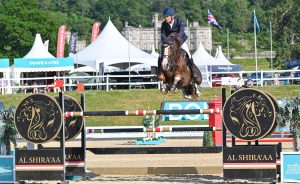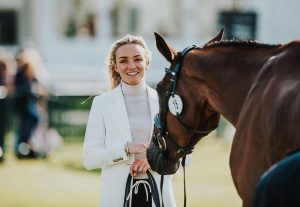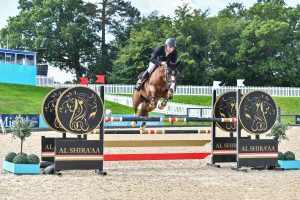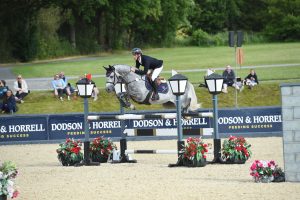Horse Scout Blogger was speaking with a rider coming up to their first competition level hike. At home they have been performing well and are well prepared in terms of ability and focus and will do well if our rider focuses on what the horse needs from him……The BIGGEST secret to you performing at your best, when it counts the most, is learning how to keep yourself CALM and COMPOSED. If you allow yourself to get too nervous or too excited right before or during a competition, then your muscles will tighten up, you’ll lose your confidence and your riding will go right down the tubes!
This is what it means to CHOKE! The rider gets so nervous that he/she ends up performing tight and tentatively — a mere shadow of your normal self and this will affect your horses performance to as he picks up on your tension.
THE REAL CAUSE OF OUT OF CONTROL NERVOUSNESS
Runaway, pre-competition nervousness can come from a lot of different sources: how good the other contestants are; the level at which you are competing; how important a competition is; how big the crowd is (and possibly more important to you – who in it is watching you; whether you’ll ride well today and win; How will the going be; Will you remember your test/course/timings— the list goes on and on.
While there are many things about your competitions that can potentially make you nervous, the true cause of your performance-disrupting nervousness isn’t any of the things that I’ve just mentioned above. The real cause of your out-of-control nerves is you! That’s right! YOU make YOURSELF nervous!
What I’m saying here is very important — It’s not what’s happening around or outside of you that makes you nervous. It’s what’s happening INSIDE that is the real cause of stress!
So it is important to take on board: It’s not the size, skill level or reputation of the competition arena that makes you nervous. It’s what you say to yourself about them in the days, hours and minutes leading up to the competition that’s the real culprit in sending your heart rate and blood pressure through the roof! Nervousness is always caused by our inner response to the things that are going on outside of us. But here’s the good news about that: If YOU make yourself nervous, then YOU have the ability to change your inner response to calm yourself down under competitive pressure.
Most riders who get too nervous to ride well do so because of what they focus on and think about as the day approaches. They worry about how well they’ll ride, what people may think or say about them, etc. Focusing on any or all of these things will guarantee that your stress level will go through the attic and your performance will get stuck in the cellar! To stay calm under pressure, you must learn to go into competitions with a completely different headset and focus. I
What you need is a game plan; a game plan is a series of little mental goals that you want to bring into the performance with you. If you follow this game plan, it will guarantee that you’ll stay calm and relaxed when you perform. Remember, being your best when it counts the most is all about being loose right before and during your competitions.
Leading up to your performance –
1. KEEP YOUR CONCENTRATION IN THE “NOW”
Train yourself to keep your focus in the NOW — especially during your performance! This means that leading up to the performance, you don’t want to think about and focus on the upcoming competition and its importance. If you want to stay loose and relaxed, you must learn to keep your concentration in the now. When you’re in the action, you want to focus on one present-moment play at a time.
2. RECOGNIsE WHEN YOUR FOCUS “TRAVELS” AND BRING YOURSELF BACK
Concentrating on what is happening now and reacting to that is key. Whilst you have to anticipate your next move you must live in the now in order function from a position of strength. If your focus moves to reflect on what has happened or you start imagining the future bring your focus back.
3. KEEP YOUR FOCUS ON YOU, YOUR JOB AND YOUR PLAY
Allowing your focus to drift to anyone or anything other than you and your horse will quickly make you feel nervous. Staying focused on you and your job will keep you calm and confident.
4. DON’T COMPARE YOURSELF WITH OTHERS! Comparison will always make you too nervous to play at your best.
5. HAVE FUN – Enjoy your job
Enjoying your performance and appreciating what is going well is the secret ingredient to staying calm and doing your best when the heat of competition is turned up high. When fun goes, so will all of your skills.
6. LEAVE YOUR GOALS AT HOME
One of the biggest tension-inducing mental mistakes that you can make as an competitor is to take your goals with you into the competition. Focusing on what you need to achieve will make you too nervous to perform well and, ironically, cause you never to reach them. Instead, leave your goals at home and keep your focus in the action, on “this” movement, this turn, this half halt.
7. KEEP YOUR MIND DISTRACTED BEFORE AND AFTER GAMES
Thinking gets most performers into trouble and makes them nervous. While you can’t really stop yourself from thinking, you can purposely distract yourself from it. So, in the days and minutes leading up to a big performance or tournament, keep busy. Do not allow yourself a lot of free time to think. If you are going through your test or riding the course in your mind. Think about HOW you re riding each movement or jump etc not how difficult its going to be.
8. KEEP YOUR FOCUS OF CONCENTRATION AWAY FROM THE “UNCONTROLLABLES”
There are a lot of things that happen in your sport that you do not have direct control over. Any time an competitor focuses on an “uncontrollable” (UC), they will get really nervous, lose their confidence and ride badly. So make a list of all of the things about this upcoming competition that you can’t directly control. For example, the officiating; the crowd; the future, such as the outcome, how well you’ll ride, winning or losing; how you are feeling that day; other people’s expectations; etc., and post the list in a highly visible. Keep in mind that these UCs are mental traps. They are lying in wait for you and every other competitor in that competition. Concentrate on the things over which you do have control.
Remember, if you really want to ride well, you have to stay loose and relaxed. To do this, focus on executing this GAME PLAN!
GoodLuck





